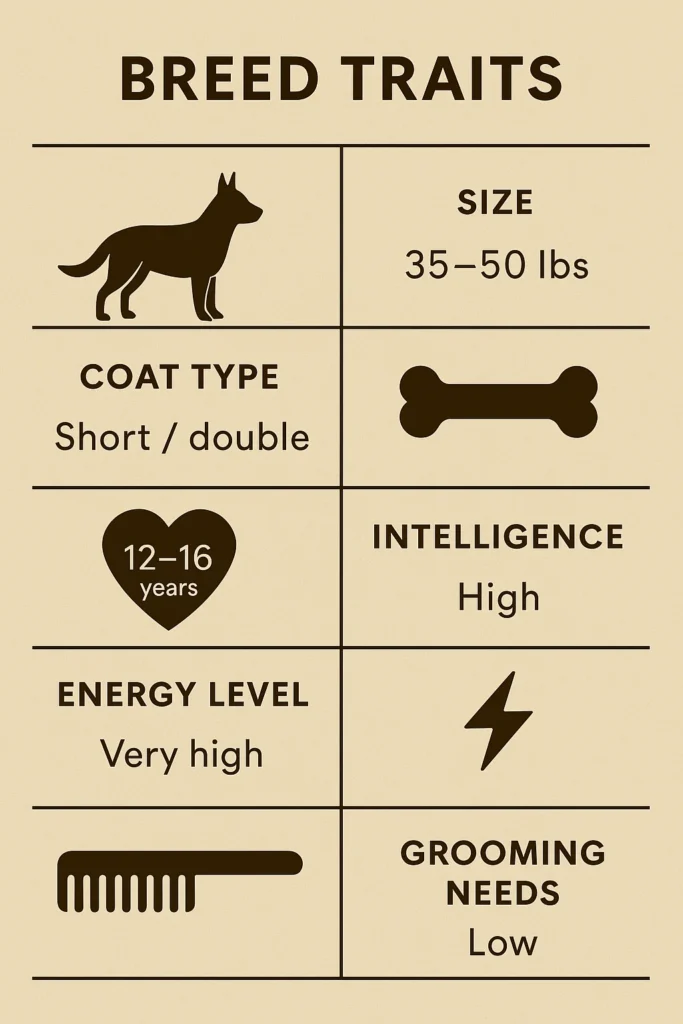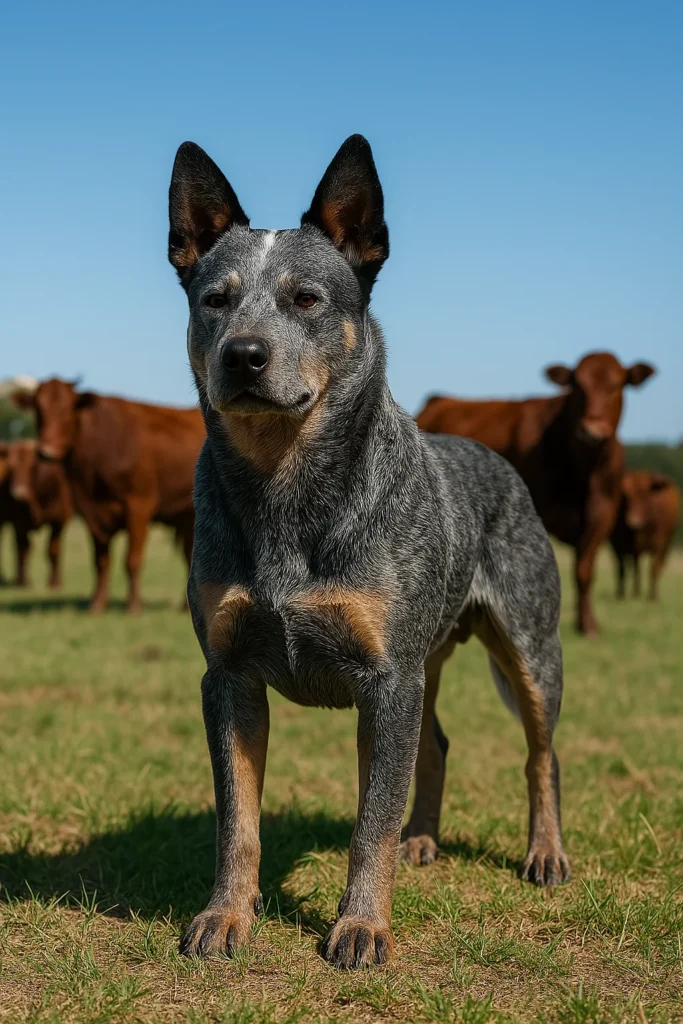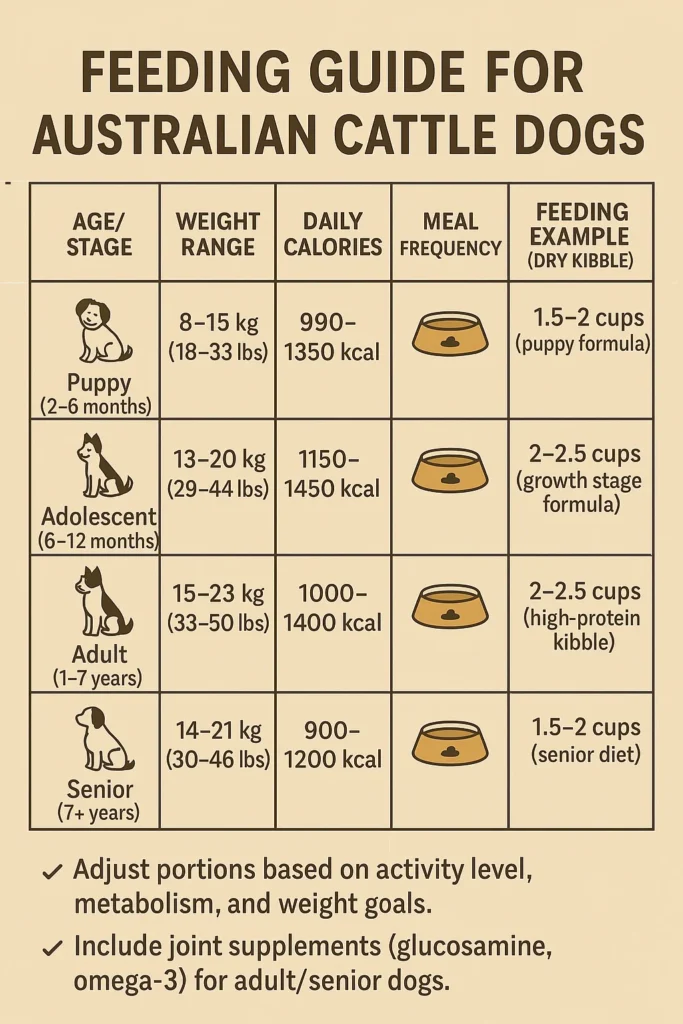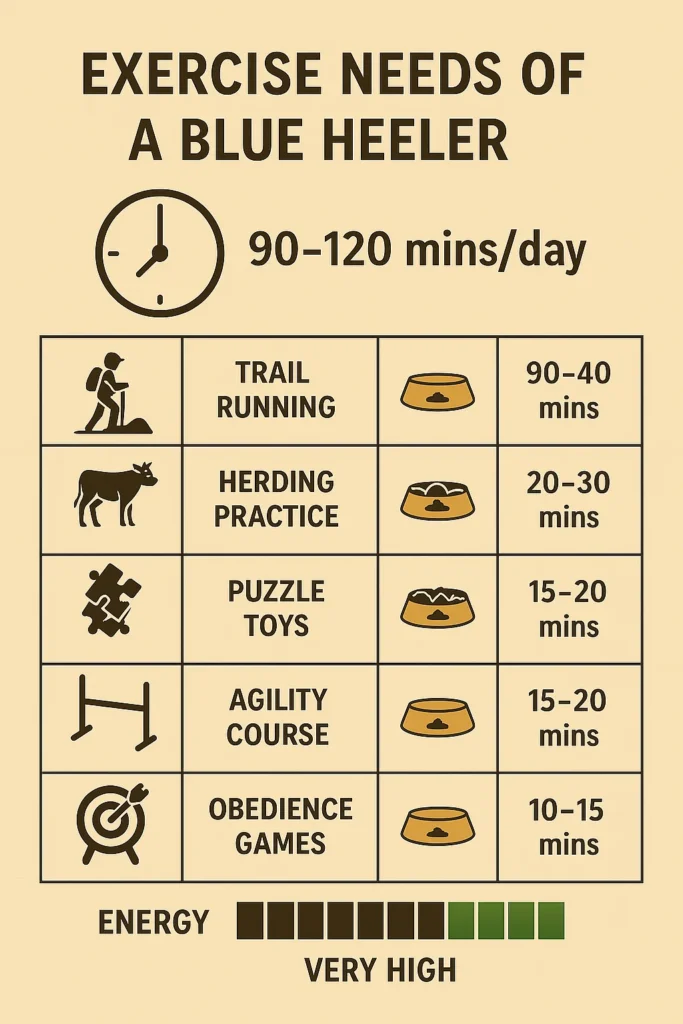Are you searching for a loyal adventure buddy or a smart canine who performs best with orders and intentional goals? So, get ready to explore all the essential facts about the Australian Cattle Dog, also known as the Blue Heeler, Red Heeler, or Queensland Heeler.
The Australian Cattle Dog (ACD), is a rugged ranch hand with the heart of a loyal family protector. Regardless of whether you live on acres of farmland or, alternatively, simply love the outdoors, this high-drive herding breed brings matchless energy, intelligence, and devotion to the table.
However, make no mistake as this isn’t your average lap dog. Above all, the Australian Cattle Dog is built to work, to run for miles, and to form powerful bonds with its humans. In fact, with sharp instincts and incredible endurance, they’re happiest when they have a job to do. In my opinion, few breeds match this combination of drive, loyalty, and work ethic.
What Is an Australian Cattle Dog? Key Traits & Facts
Energetic and medium-sized, the Australian Cattle Dog is a working breed that was originally bred in Australia for driving cattle over vast, rugged distances. Specifically, These dogs were designed for toughness, obedience, and intelligence. As a result, they are ideal for working farms, active households, and outdoor-loving individuals.
Australian Cattle Dogs are known for their problem-solving ability and fierce loyalty. Additionally, they excel in herding, agility, search and rescue, obedience competitions, and protection work. Consequently, their keen senses and tireless stamina give them an edge that few breeds can match.
In any case, whether you’re looking for a dog that can hike, herd, guard, or simply be a loyal shadow, the Australian Cattle Dog is the best fit breed. That said, if you’re ready to meet their physical and mental demands.
Origins & History of the Australian Cattle Dog (Blue Heeler)
In the early 1800s, Australian cattle ranchers needed a herding dog that could endure harsh climates, rugged landscapes, and long working days. To address this, enter Thomas Hall, who crossed British herding breeds with tame Dingoes, creating the earliest versions of the Blue Heeler we know today.

As Australia’s cattle zones expanded, over time, breeders mixed in Kelpies for agility, Dalmatians for companionship, and Bull Terriers for determination. Eventually, By the late 1800s, the Australian Cattle Dog had taken shape: robust, quick, and intelligent.
In 1893, the first recorded “Blue Heeler” trials were held, and the first official Breed Standard was published in 1903. Eventually, in 1980 this breed was recognized by American Kennel Club. Still, the breed’s herding instincts remain sharp, though they’ve adapted to urban life as family protectors and competitors in canine sports.
Australian Cattle Dog Appearance & Coat Types
The Blue Heeler is known for its sturdy, athletic body—with strong shoulders, a flat topline, and sound hocks built for speed and endurance.

Unique Traits
- Notably, upright, triangular ears poised for sound detection
- Additionally, oval-shaped, intelligent eyes—usually brown or hazel
- Low-set, bushy tail—held high when excited
Common Coat Colors
- Blue mottled or speckled, sometimes with black patches
- Red speckled, often with subtle rust markings
- Rarely, white markings or what breeders call the “Bentley mark”—a white blaze on the forehead
As a result, their weather-resistant double coat helps them thrive in extreme temperatures, repelling dirt and moisture while keeping them cool or warm depending on the season.
Australian Cattle Dog Overview: Traits, Blue & Red Heeler Facts

| Feature | Description |
| Coat | Short, dense, double-layered |
| Color | Blue, red, black, white patches |
| Weight | 35–50 lbs (average adult range) |
| Height | 17–20 inches at the shoulder |
| Lifespan | 12–16 years (Bluey lived to 29) |
| AKC Group | Herding |
| Energy Level | Very High |
| Intelligence | Exceptional |
| Grooming Needs | Low to moderate |
| Suitable For | Active families, farms, agility competitors |
Australian Cattle Dog Temperament & Behavior Overview
In essence, the temperament of this breed is a blend of independence and strong loyalty. They are confident, vigilant, and deeply bonded to their family.
Moreover, they’re fiercely protective—willing to sound the alarm or confront danger. Otherwise, if unwatched, they can become demanding or stubborn. Using their intelligence to manipulate owners or resolve problems on their own terms.

Ideal Temperament Traits
- Devotion to one primary guardian
- High tolerance for new situations after early socialization
- Independent thinker—appreciates structure but thrives on trust
- Warners and watchdogs—rather than yappers
Above all, they love challenge and purpose. With regular mental and physical training, they become well-mannered, well-rounded dogs. Without it, consequently, their energy can spill over into undesirable behaviors. Undoubtedly, their strong will and loyalty make them incredibly rewarding—but only for those prepared to match their intensity.
Australian Cattle Dog Size, Weight & Lifespan
Australian Cattle Dogs are medium-sized but solidly built for hard work and endurance.
| Gender | Weight | Height |
| Male | 40–50 lbs | 19–20 inches |
| Female | 35–45 lbs | 17–19 inches |
Lifespan: On average, Australian Cattle Dogs typically live 12–16 years. Remarkably, one famous dog named Bluey defied the odds by living to 29 which is the longest lifespan ever recorded for a dog and a remarkable example of the breed’s resilience.
Common Health Issues & Preventive Care for Australian Cattle Dogs
Australian Cattle Dogs are relatively healthy compared to other breeds, but they can be prone to these issues:
- Hip Dysplasia – Malformed hip joints leading to arthritis
- PRA (Progressive Retinal Atrophy) – Genetic eye disorder causing vision loss
- Deafness – Particularly in lines with piebald or merle genes; BAER testing is essential
- Elbow Dysplasia – Joint abnormalities causing pain and reduced mobility
To reduce the risk, take steps to prevent or manage these:
- First and foremost, prioritize genetic-sound breeding and testing
- To support this, use foods rich in omega-3 fatty acids for joint and coat health
- Maintain lean body condition to reduce joint stress
- Schedule annual checkups, including hip, eye, and hearing screenings
Grooming & Maintenance Tips for Australian Cattle Dogs
Surprisingly, despite their love for the outdoors, Blue Heelers are easy to groom if their coat and diet are maintained properly.
- Brush Ideally, 1–2 times weekly, more during shedding season
- Bathe every 4–6 weeks or as needed
- Trim nails monthly
- Clean ears weekly to avoid infections
- Brush teeth 2–3 times per week to prevent plaque buildup
In truth, they’re not hypoallergenic—they shed moderately in spring and fall. Regular brushing minimizes hair and keeps your home hair-free.
Australian Cattle Dog Exercise Needs & Mental Stimulation
Australian Cattle Dogs need high-intensity exercise and cognitive engagement.
Daily Minimum
- 90 to120 minutes of physical activity
Excellent Activities
- For instance, excellent activities include herding simulations or obedience drills
- Trail running, mountain hikes, or biking
- Agility courses and flyball competitions
- Puzzle toys, scent games, or interactive play
- Real-world “jobs”—retrieving tools, alerting gates, or pulling carts
Pro Tip: Devote 10 to 20 minutes of mental tasks like scent work or obedience at the start of walks to satisfy their brain before physical exercise.
Otherwise, without enough mental and physical activity, they might turn to herding or playing with household items like couches, shoes, or garden beds—often leading to unwanted destruction.
Australian Cattle Dog Training Tips & Success Stories
Australian Cattle Dogs are highly trainable—that’s part of why they became herders in the first place. Use proven Australian cattle dog training tips such as consistency, challenge-based rewards, and herding cue commands. If you’re on a farm, you can even train a cattle dog to herd using step-by-step exposure methods.
Best Training Tips
- Begin training as early as 8–10 weeks
- Keep sessions fun, brief, and positive
- Use treats, clickers, toys, and praise
- Add whistle signals and hand cues
- Incorporate structured rest periods—they work intensely, then recover
From experience, I’ve seen how consistent, early training transforms these dogs into amazing companions. One inspiring story is from Montana, where a dog named “Blue” learned to herd over 300 cattle using only hand signals and whistle cues. His trainer credits this success to firm, consistent methods and plenty of outdoor exposure starting from puppyhood.
Are Australian Cattle Dogs Good Family Pets?
Many ask: Are Blue Heelers good family dogs? Yes, especially for older kids and experienced dog owners. With proper training, Cattle Dogs make excellent family pets, but they come with responsibilities. Nevertheless, mini Australian Cattle Dog facts reveal that smaller versions (often mixed) may be more adaptable for urban homes.

Pros
- Loyal to the family
- Protective instincts
- High trainability and intelligence
- Quiet watchdogs
Cons
- Heel-nipping tendencies around small kids
- Cannot be left alone for long without activity
- Require early socialization to prevent mistaken herding
In that case, families with time, space, and energy can adopt this breed. In my view, they thrive best in households where everyone contributes to the dog’s routine and enrichment.
Australian Cattle Dog Mixes & Crossbreeds Overview
Breed mixes combine the cattle dog’s traits with others for varied lifestyles.
- Lab Heeler – Friendly and energetic; loves water
- Husky Heeler – Vocal, gorgeous coat, high energy
- Shepherd Heeler – Protective, vigilant, family-oriented
- Border Collie Heeler – Intense, focused, perfect for sports-oriented households
That said, these hybrids often retain the cattle dog’s energy and drive—but may have added challenges like vocalization or sensitivity to cold (from Husky heritage).
Australian Cattle Dog Feeding & Nutrition Guidelines
A high-performance dog needs a high-quality diet.
Diet Recommendations
- Protein from meat as first ingredient
- Complex carbs and limited fillers
- Joint supplements: glucosamine, chondroitin
- Portion control—no free feeding
- Freshwater always available

To guide you, here’s a feeding guideline table for the Australian Cattle Dog
| Age/Stage | Weight Range | Daily Calories | Meal Frequency | Feeding Example (Dry Kibble) |
| Puppy (2–6 months) | 8–15 kg (18–33 lbs) | 990–1350 kcal | 3–4 meals/day | 1.5–2 cups (puppy formula) |
| Adolescent (6–12 months) | 13–20 kg (29–44 lbs) | 1150–1450 kcal | 2–3 meals/day | 2–2.5 cups (growth stage formula) |
| Adult (1–7 years) | 15–23 kg (33–50 lbs) | 1000–1400 kcal | 2 meals/day | 2–2.5 cups (high-protein kibble) |
| Senior (7+ years) | 14–21 kg (30–46 lbs) | 900–1200 kcal | 2 meals/day | 1.5–2 cups (senior diet) |
- To clarify, adjust portions based on activity level, metabolism, and weight goals.
- Include joint supplements (glucosamine, omega-3) for adult/senior dogs.
Apartment Living with Australian Cattle Dogs: What You Need to Know
They aren’t typically considered suitable for cattle dog apartment living, but with the right measures, it can be made to work.
What Works
- At least 2 hours of daily exercise
- Mental toys and short training sessions throughout the day
- Regular dog‑park visits or hiking outings
- If necessary, use a professional dog walker or daycare during long hours alone
Ultimately, a backyard and a couple of well‑structured walks suit the breed much better.
Australian Cattle Dog Breeders vs. Rescues: What to Know
The price of an Australian Cattle Dog can vary based on its pedigree, coat color, and the reputation of the breeder. On the other hand, while adopting from a rescue is often more budget-friendly, both paths can be incredibly fulfilling. Therefore, one has to consider the pros and cons before making a decision.
Buying from a Trusted Breeder
- Price range: Generally speaking, the price range is $800 to $1,500
- Includes health screenings for issues like hip dysplasia, deafness, and eye conditions
- Pups are usually registered with the AKC and may go through early behavior testing
- Best suited for those who want a puppy with a known lineage, predictable traits, and thorough health history
Adopting from a Rescue
- Adoption fee: usually $200 to $500
- Dogs may be older but often come with basic training or house manners
- A wonderful option for those who want to offer a second chance to a dog in need
- Check with reputable organizations such as Australian Cattle Dog Rescue Colorado
- Ideal for families who want to make a difference and don’t necessarily need a puppy
Australian Cattle Dog vs. Border Collie: Breed Comparison
| Feature | Cattle Dog | Border Collie |
| Energy | High | Very High |
| Trainability | High | Exceptional |
| Independence | More independent | Sensitive, people-focused |
| Grooming Needs | Low to moderate | Moderate |
| Herding Style | Heel-nipping | Eye-stalking |
In comparison, while both are exceptional, the Cattle Dog is rugged and self-sufficient, whereas the Border Collie is intense and attentive to human interaction.
Name Ideas for Your Australian Cattle Dog (Blue Heeler)
| Category | Names |
| Male Names | Rusty, Bandit, Diesel, Ace, Ranger |
| Female Names | Skye, Pepper, Blaze, Storm, Taz |
| Aussie-Inspired | Boomer, Kylie, Matilda, along with working-themed names such as Scout or Maverick |
Australian Cattle Dog FAQs: Common Questions Answered
Q1: Are they aggressive?
Not inherently. Their protective behavior needs clear leadership to avoid over-reactive guarding.
Q2: Do they get along with cats?
Possible with early introduction, supervised interactions, and tasks to redirect chasing instincts.
Q3: Can they live in apartments?
Yes, with heavy exercise, mental enrichment, and regular outings.
Q4: Do they bark a lot?
Not excessively—they bark when alert or bored.
Q5: How expensive are they?
$800–$1,500 from breeders; $200–$500 from rescues.
Q6: Do they shed?
Yes, seasonally—but regular brushing helps manage.
Q7: Are they kid-friendly?
Yes, with training; but they may nibble heels unless discouraged.
Q8: Is “Mini Blue Heeler” real?
Not a recognized breed—some breeders mix smaller dogs to mimic the look.
Q9: Hypoallergenic?
No, they aren’t—so they’re not suitable for allergy sufferers.
Q10: What is the Blue Heeler lifespan?
A: Typically, most live between 12–16 years, though some reach 18+ with proper care and a healthy lifestyle.
Final Thoughts on Australian Cattle Dogs: Is This Breed Right for You?
To conclude, I must say that The Australian Cattle Dog is a true working companion, they are the true symbol of loyalty, intelligence, and endurance. They’re for owners who love adventure, structure, and close bonded teamwork with their dog.
In short, expect a partner who:
- Works hard and plays hard
- Demands mental and physical challenges
- Forms a bond with unwavering loyalty
If you’re ready to meet the breed at their best—rugged, smart, loving—then the Blue Heeler may just reward you with a lifelong companion like no other.

